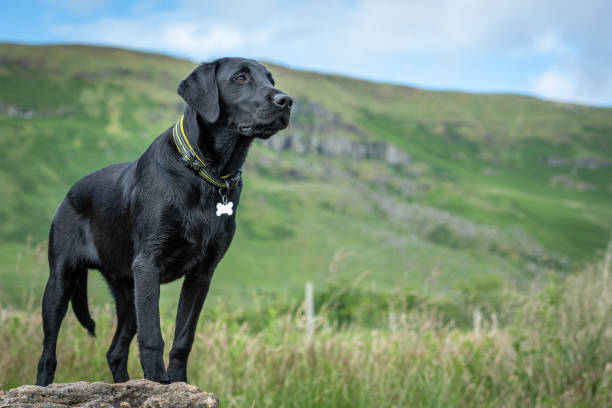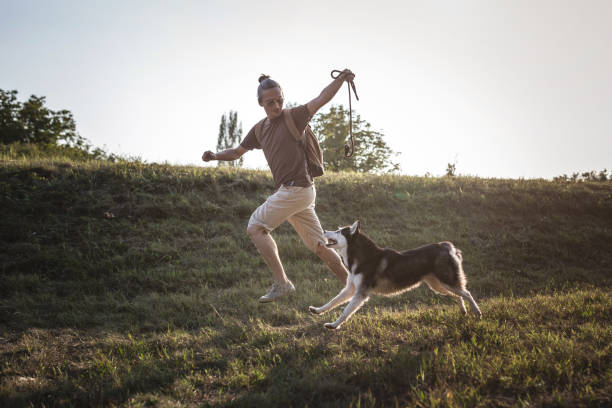For outdoor enthusiasts who love staying active on the trails, having a furry companion by your side can make adventures even more enjoyable.
But when it comes to picking the right dog breed for running and hiking, some are better suited for covering long distances and rough terrain than others.
As an experienced hiker and trail runner myself, I’ve learned that certain qualities like stamina, athleticism, intelligence, and trainability are most important for these activities. Over the years, I’ve also discovered which dog breeds truly shine in the great outdoors.
In this ultimate guide, I’ll cover everything you need to know about choosing the best dogs for running and hiking the trails, from breed overviews to buying considerations.
I’ll also share training tips, hiking must-haves, and answers to frequently asked questions. Let’s hit the ground running!
The Best Dogs for Running and Hiking
Not all dogs are cut out for miles of jogging and climbing over rocks. When searching for an active companion, opt for breeds with natural endurance, agility, and focus. Based on experience and expert input, here are my top picks:
1. Labrador Retriever

With their sturdy build, loyal temperament, and eagerness to please, it’s no wonder Labrador Retrievers are the most popular breed in the US.
Their athleticism and endurance allow them to keep up on any adventure. Labs are highly trainable and intelligent, able to navigate obstacles on the trail. Their friendly nature makes them great motivators too!
2. Golden Retriever

Similar to the Lab, the family-friendly Golden Retriever has an ideal combination of energy, obedience, and durability for outdoor activities.
Goldens thrive when given a “job” to do and plenty of exercise. They’re powerful but graceful runners who can handle long distances. Their lush coat provides insulation from cool weather.
3. German Shorthaired Pointer

Bred as an all-purpose gun dog, German Shorthaired Pointers have exceptional stamina and speed. They need lots of activity and mental stimulation.
With a weather-resistant coat, this lean breed can run for miles without tiring. Their strong prey drive requires training for off-leash reliability.
4. Vizsla

An athletic hunting dog from Hungary, the Vizsla excels at field work and hunting. They have a light, short coat and muscular build perfect for running and hiking.
Vizslas are very active, affectionate, and eager to please. They bond closely with their owners and always like to be by your side. Obedience training is a must for this sensitive breed.
5. Border Collie

Considered the smartest of all dog breeds, the Border Collie is a top choice for active owners. They thrive when challenged mentally and physically.
Their lightweight frame allows them to run, hike, and play fetch for hours. Borders have plenty of energy and stamina but are also highly trainable and focused on their person.
6. Australian Shepherd

A working ranch dog, Australian Shepherds are tough, intelligent, and energetic. Their thick coat provides insulation on the trail and resistance to rain and snow.
Aussies have a loyal, work-oriented personality perfect for hiking companions. Off-leash reliability takes training as they have a strong herding instinct.
7. Weimaraner

Weimaraners are graceful athletes originally bred to hunt large game. These Grey Ghost dogs have swift speed, stamina, intelligence, and desire to be with their owners.
Their short coat gives them versatility in different environments. Weimaraners need plenty of exercise along with training to channel their energy.
Other excellent breeds for running and hiking include:
- Rhodesian Ridgeback
- Jack Russell Terrier
- Dalmatian
- Brittany
- Mutts! Don’t overlook this. Mixed breeds often have hybrid vigor.
Buying Considerations
If one of the breeds above caught your eye, keep the following factors in mind while searching for your perfect pup:
Age – Opt for a young adult or adolescent dog aged 1-3 years old. Puppies under a year may not be ready for extended hiking. Senior dogs won’t have as much energy.
Breeder/Rescue/Shelter – Seek out responsible breeders who focus on health and good temperament. Rescues and shelters are another great option. Ask questions about activity level.
Energy Level – Look for a dog with an energetic, lively temperament – not one that is shy or overly mellow. Recall breeds were historically bred as hunting, sporting, or working dogs.
Size – Medium or large breeds (40-80 lbs) are best for covering long distances comfortably. Small dogs may struggle. Giant breeds prone to joint issues aren’t ideal.
Coat – A multi-layered, weather-resistant coat protects against elements on the trail. Short to medium length is typically best and low maintenance.
Health – Confirm the dog has received clear OFA certifications for hips/elbows. Ask about eye exams and genetic testing too.
Personality – Choose an outgoing, people-focused dog who engages easily with strangers. Skittish or aloof dogs won’t thrive on hikes.
Training Tips
To hit the trail safely and happily with your furry hiking buddy, proper training and socialization are a must. Here are my top tips for preparing your dog for running and hiking adventures:
- Start young with obedience training using positive reinforcement. Work on basic cues like sit, stay, come, heel.
- Gradually build your dog’s endurance and mileage. Conditioning is key to avoiding injury. Start slow.
- Expose your dog to new sounds, environments, people, wildlife, and other dogs in a controlled, positive way.
- Teach a reliable recall using high-value rewards. Voice control keeps your dog safe off leash.
- Get your dog comfortable wearing a pack loaded with weight. It conditions them to hike long distances.
- Practice having your dog walk calmly beside you or behind you – not pulling on the leash out in front.
- Desensitize paws to different surfaces like slickrock, gravel, and scree using treats and praise. Toughen those paw pads!
- Set clear expectations and rules for behavior on the trail. Use cues like “leave it” and “on by” when passing other dogs or people.
With consistent training, you’ll have a trustworthy trail companion you can rely on in any situation. Be patient – the effort pays off!
Essential Gear & Accessories
Hitting the trail with your dog requires some key gear and accessories for comfort, safety, and convenience. Here’s what to pack:
For You:
- Sturdy hiking shoes or boots with ankle support and traction
- Wool socks to prevent blisters
- Lightweight, breathable hiking clothes that block sun and bugs
- Windproof outer layer for changeable weather
- Sunglasses, hat, sunscreen
- Plenty of water and snacks/lunch
- First aid kit
- Navigation essentials (map, compass, GPS)
- Cell phone, walkie talkies, whistle
- Hiking poles for balance
- Bear spray if needed
For Your Dog:
- Well-fitted harness and leash designed for hiking
- K9 backpack to carry dog food, bowl, toys, first aid
- Collapsible dog bowl
- Dog food and high protein, low-calorie hiking treats
- Plenty of water
- Waste bags for cleaning up after your dog
- Dog first aid kit with foot protection, wound care items
- Foldable dog bedding or coat for resting
- Dog lifejacket if swimming
- Bright dog tag with your contact info
- Dog GPS tracker (if hiking off leash)
With the right preparation, gear, and training, you and your furry best friend will be ready for an epic adventure on the trails! Time for some fun.
Also Read: The 5 Best Hiking Boots for Flat Feet: A Buyer’s Guide
Finding the Right Hiking Spot
To have a safe and enjoyable time running or hiking with your dog, location is key. Here are tips for finding a suitable trail or park:
- Check regulations – some trails prohibit dogs or require leashes
- Look for dog-friendly areas with plenty of space to explore off leash
- Seek out quiet trails to avoid encounters with unfriendly dogs/people
- Find spots with natural water sources for your dog to cool off
- Choose wooded trails for shade rather than fully exposed hikes in hot weather
- Know trail difficulty – is it suitable for your dog’s conditioning level?
- Beware of potential wildlife conflicts like snakes, bears, mountain lions
- Ask other active dog owners for local recommendations
- Consider driving distance and parking availability
Ideally the trail will have a gentle incline without dangerous dropoffs, as well as clearly marked navigation paths.
Steep, rocky terrain can be tiring and hard on paws. Well-maintained trails are easiest to navigate and minimize overgrowth.
It’s also wise to check the forecast before heading out. While dogs thrive in cool weather, heat and humidity can quickly become dangerous.
Plan accordingly and adjust distance/difficulty as needed. With some strategic planning, you’re sure to find the perfect spot!
Safety Tips for Trail Running & Hiking with Dogs
When adventuring in the wilderness with your furry companion, safety should be the number one priority. Here are some key tips to follow:
- Always bring more water than you think you’ll need and take frequent hydration breaks. Overheating is a real risk for dogs.
- Know your limits and don’t push too far too fast. Gauge your dog’s energy level and take a break or turn back if needed.
- Make sure your dog is conditioned and in shape for the mileage/terrain. their pads should be toughened. Build up distance gradually.
- Carry dog first aid gear and know basic skills like cleaning wounds or bandaging paws. Familiarize yourself with signs of heat stroke.
- Keep your dog on a leash if wildlife like moose or bears are a concern. Don’t allow chasing.
- Use a flashing collar and leash at night or low light conditions for visibility.
- Avoid midday sun when it’s hottest. The best times to hike are morning and evening.
- Bring tick prevention and check yourself and your dog thoroughly after each hike.
- Watch for sharp sticks, cactus, foxtails, and other hazards that could lodge in paws.
- Monitor weather closely. Thunderstorms and high winds can develop quickly.
- Pack extra layers, food and emergency blanket in case you’re stuck out longer than planned.
- Consider rattlesnake avoidance training for dogs in high risk areas. Teach cues like “leave it.”
Proper preparation and safety knowledge gives you the confidence to explore trails worry-free with your trusted companion. Stay vigilant and use caution when adventuring into the unknown.
Also Read: The Best Hiking Backpacks for Tall Guys – A Mom’s Honest Review and Buyer’s Guide
Top Hiking Destinations with Dogs
Looking for inspiration on where to enjoy your next outdoor adventure with your furry friend? Here are some of the top hiking destinations across the U.S. that welcome dogs:
– Acadia National Park, Maine – Iconic granite peaks and ocean views. Avoid nesting falcons in spring.
– Big Sur, California – Rugged coastal trails and breathtaking waterfalls along Highway 1.
– Boulder, Colorado – Miles of scenic foothills trails starting right from town.
– Shenandoah National Park, Virginia – Ridge hikes and wooded trails under a lush canopy.
– Pacific Northwest – Anywhere from Portland to Seattle offers endless options. Dog favorite Mt. Rainier a top pick.
– White Mountains, New Hampshire – Waterfalls, presidential peaks, and great swimming holes.
– Great Smoky Mountains, Tennessee/North Carolina – Gradual inclines and swimming holes like the Appalachian Trail.
– Lake Tahoe, California/Nevada – alpine lakes, granite slabs, and peaks made for epic views.
– Champlain Valley, Vermont – Quaint villages, green mountains, and Lake Champlain shores.
– Black Hills, South Dakota – Iconic granite formations and prairie hikes abound.
Wherever your adventures take you, be sure to call ahead about dog rules and pack plenty of water.
The right location makes all the difference when hitting the trails with your furry companion. Now it’s time to get out there and explore!
FAQs: Best Dog for Running and Hiking
How much distance can a dog safely hike?
Distance depends on breed, age, conditioning level, weather, and terrain. Start with 2-4 miles on moderate terrain.
Build up your dog’s endurance gradually. Well-conditioned dogs can eventually handle 15-20 mile hikes. Take plenty of breaks and monitor for signs of fatigue or sore paws.
What essential items should I bring for day hiking with a dog?
Bring plenty of water, collapsible bowls, high-protein treats, waste bags, first aid kit, navigation, layers, and rain protection.
Use a pack for your dog to carry their own food, bowl, and supplies. Other useful items include paw balm, cooling vests, and a flashlight.
Is it OK for dogs to hike in hot weather?
Dogs can hike in hot weather, but precautions need to be taken. Avoid the midday heat.
Bring extra water, walk in shade when possible, take frequent breaks, watch closely for overheating, and keep paws on cool trail when stopped. Early morning or evening is best.
Can I hike with my dog off-leash?
Voice and sight control are imperative before hiking off leash. Start in safe areas with few hazards or distractions.
Keep a long lead line handy. Leash any time wildlife, cliffs, or other dogs are near. Know leash laws in your local parks and trails.
What should I do if my dog is limping on a hike?
First examine paws for cuts, debris, blisters, etc. Clean and bandage as needed. If the limp persists, shorten your hike and return to the trailhead.
Carry your dog if possible. Rest them for a few days and consult your vet if limping doesn’t improve.
How can I keep my dog hydrated on long hikes?
Encourage your dog to drink frequently from their collapsible bowl. Stash extra water in your pack for refills. Stop at streams, lakes, or springs.
Watch your dog closely for signs of dehydration like lethargy or excessive panting. Hydrating before, during, and after hikes is vital.
